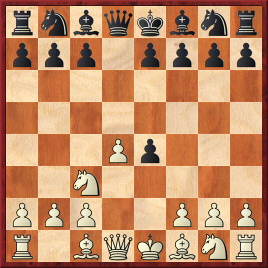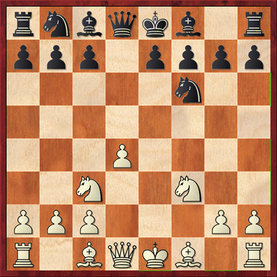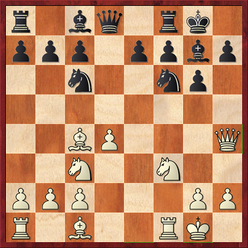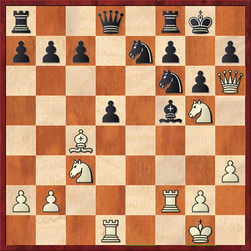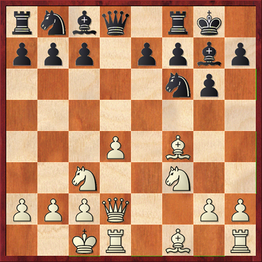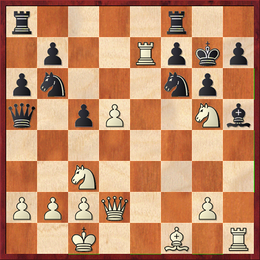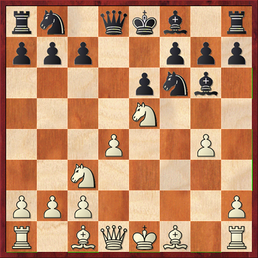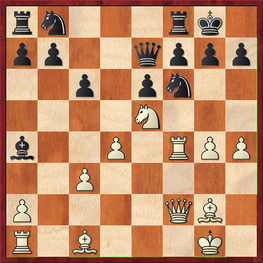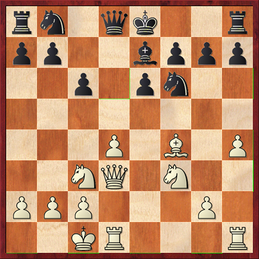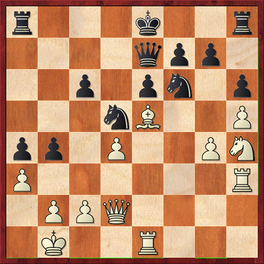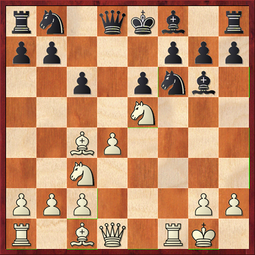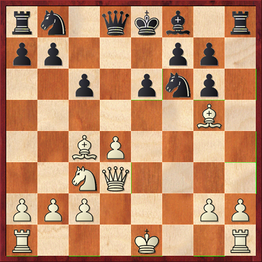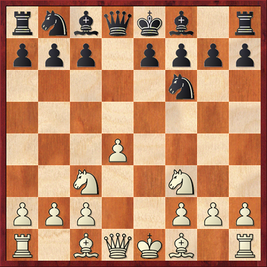Introduction
Black plays ...g6 and ...Bg7
One common plan for Black against the Blackmar-Diemer is to play ...g6 and ...Bg7. The most common version arises in the line 1.d4 d5 2.e4 dxe4 3.Nc3 Nf6 4.f3 exf3 5.Nxf3 g6, which is known as the Bogoljubov Defence. Against this, White has two main plans:
The Studier Attack
The "Long Bogo"
Black's approaches with an early ...Bf5
Gunderam Defence - White goes for an early g4
An alternative approach: exchanging light squared bishops
Ziegler Defence
Teichmann Defence - 5...Bg4
|
The most popular defence to the Blackmar-Diemer Gambit is 5...Bg4, pinning the knight on f3, and keeping open the possibility of swapping it off at the right moment. I don't think it's one of the most critical, though. After 6.h3!, 6...Bh5 7.g4! Bg6 8.Ne5 tends to transpose into the variations with 5...Bf5 6.Ne5 e6 7.g4 Bg6, but denying Black the critical alternative 6...c6 7.g4 Be6. I think White has enough for the pawn here.
You might wonder, why play 6.h3, isn't it just a waste of a tempo to provoke Black into exchanging? Well, not quite, because if White just develops normally, Black is more likely to just leave the bishop on g4, keeping the knight on f3 in an awkward pin. Also, the move 6.h3 prepares g2-g4, which threatens to kick the black knight away from f6 at a good moment with g4-g5. Then in various lines the bishop on f1 can come out to g2, rather than its more traditional post on c4. |
More consistent is to meet 6.h3 with 6...Bxf3 7.Qxf3 c6 (7...Nc6 walks into an awkward pin after 8.Bb5, threatening 9.d5).
Then it's not clear if White can get enough compensation for the pawn with the routine 8.Be3, but White has a more violent alternative in 8.g4!?, sacrificing a second pawn on d4, with the idea of quickly bringing a rook to f1, playing g5 and then breaking through to Black's weak point on f7 (this highlights another useful point behind 6.h3). If Black takes on d4, White can play Be3 and 0-0-0 and gets very dangerous compensation, while if Black doesn't take, White tends to get into favourable versions of the 8.Be3 lines. |
Euwe Defence - 5...e6
|
5...e6 is a solid but passive defence to the Blackmar-Diemer, shutting in the bishop on c8, and aiming for rapid kingside development. If White plays 6.Bd3, 6...c5! is quite awkward to meet, so White does best to pin the knight on f6 with 6.Bg5. Then if 6...c5, 7.Bxf6, intending 7...Qxf6 8.Bb5+ followed by 0-0 and/or Ne5, gives White a dangerous initiative. Thus, Black tends to continue with 6...Be7 (diagram).
Here White has two main options. |
7.Bd3 is the traditional main line. Joe Gallagher and James Rizzitano have recommended 7...c5, but I think White can get away with 8.dxc5, followed by either 9.0-0, or 9.Qe2 and 10.0-0-0, with plenty of compensation for the pawn in either case. Also, Black should probably avoid the "automatic" 7...0-0, because then 8.0-0 followed by Qe1 and Qh4 gives White a dangerous attack, with the bishop on d3 pointing at h7, and the threat of Rxf6 sacrifices.
The most challenging reply to 7.Bd3 is rather 7...Nc6, with the idea of exchanging off the bishop on d3 with ...Nb4 and ...Nxd3. White can continue with either 8.a3 (preventing ...Nb4, but at the cost of time) or 8.Qd2 (allowing the exchange). Lev Zilbermints has favoured 8.0-0 Nxd4 9.Kh1, sacrificing a second pawn, but if Black isn't tempted by 9...Nxf3?! 10.Qxf3, which is dangerous for Black, Black has good chances of getting the upper hand. |
|
The other way to continue is 7.Qd2, preparing queenside castling. Here White can continue with Qd2-f4-h4, and get the queen across that way. White has had many nice wins where Black has played ...0-0 and ...h6, and fallen for a very strong Bxh6 sacrifice.
|
Some intriguing comparisons with the 3...Qd8 Scandinavian - what to make of that missing pawn on f2?
4th-move alternatives
After 3...Nf6, White doesn't get very far with 4.Bg5, and so should prefer the main line with 4.f3. Then Black can consider 4...Bf5, the Vienna Defence, which allows White to charge forward with the kingside pawns after 5.g4, but this leaves White's kingside weak, so White probably does best to persist in sacrificing a pawn with 5.fxe4 Nxe4 6.Qf3, after which White can get sufficient compensation.
4...c6, the O'Kelly Defence, is quite challenging, since 5.Nxe4 gives Black a few reasonable equalising options including 5...Nbd7 and 5...Nxe4 6.fxe4 e5 7.Nf3 Be6, and 5.fxe4 runs into 5...e5. Therefore White should prefer 5.Bc4, whereupon 5...exf3 6.Nxf3 Bf5 transposes into the Ziegler Defence. Black can also try 5...b5!? (Short-Bareev, Sarajevo 2000) whereupon White can improve over Short's play and get enough compensation for the pawn, but has to play accurately for a few moves.
4...c6, the O'Kelly Defence, is quite challenging, since 5.Nxe4 gives Black a few reasonable equalising options including 5...Nbd7 and 5...Nxe4 6.fxe4 e5 7.Nf3 Be6, and 5.fxe4 runs into 5...e5. Therefore White should prefer 5.Bc4, whereupon 5...exf3 6.Nxf3 Bf5 transposes into the Ziegler Defence. Black can also try 5...b5!? (Short-Bareev, Sarajevo 2000) whereupon White can improve over Short's play and get enough compensation for the pawn, but has to play accurately for a few moves.
Ryder Gambit: 3...Nf6 4.f3 exf3 5.Qxf3
With 5.Qxf3 White sacrifices a second pawn, but the move is rather dubious. If Black simply declines the second pawn, say, with 5...c6, then White is probably worse off than after the knight recapture, while the traditional "book" recommendation, 5...Qxd4 6.Be3 Qg4 7.Qf2 e5, is favourable for Black. Mark Nieuweboer's preference 6...Qh4+ 7.g3 (taking the g3-square away from the white queen) 7...Qb4 may be even stronger. However, White's score in the databases is quite good, suggesting that the line offers practical chances.
3...Nf6 4.f3 exf3 5.Nxf3 Bg4 and 5th-move alternatives
5...Bg4 is the most popular of Black's 5th-move options, pinning the f3-knight and weakening White's control of the centre, but it is not one of the more theoretically challenging options. White generally kicks the bishop immediately with 6.h3, which is quite a useful pawn move as it also prepares g2-g4. Then after 6...Bxf3 7.Qxf3 c6 (6...Nc6 runs into 7.Bb5) White chooses between the solid 8.Be3, defending d4, 8.Qf2, and the bolder 8.g4!?, which offers the sacrifice of a second pawn at d4, which Black probably does best to accept, since if Black declines it, then White has few problems getting enough compensation for the pawn.
Instead Black can retreat the bishop with 6...Bh5, whereupon 7.g4 Bg6 8.Ne5 usually follows. White will follow up with Bf1-g2 and h3-h4 in most cases, threatening h4-h5, and White's pressure provides sufficient compensation for the pawn.
Other 5th moves for Black are not too challenging, e.g. 5...Nc6 6.Bb5, 5...Qd6 6.Ne5.
Instead Black can retreat the bishop with 6...Bh5, whereupon 7.g4 Bg6 8.Ne5 usually follows. White will follow up with Bf1-g2 and h3-h4 in most cases, threatening h4-h5, and White's pressure provides sufficient compensation for the pawn.
Other 5th moves for Black are not too challenging, e.g. 5...Nc6 6.Bb5, 5...Qd6 6.Ne5.
3...Nf6 4.f3 exf3 5.Nxf3 e6
This is generally known as the Euwe Defence and it is solid but rather passive. Play usually continues 6.Bg5 Be7 and White can choose between 7.Bd3 and 7.Qd2. I think 7.Qd2 is the more promising of the two options, since I'm not sure about White's compensation in the 7.Bd3 Nc6 variation, counterattacking against d4, where White has to either spend a tempo with 8.a3, allow the exchange of the important d3-bishop with 8.Qd2 Nb4, or boldly sacrifice a second pawn with the Zilbermints Gambit, 8.0-0, which is dangerous but most likely insufficient. After 7.Qd2, preparing to castle queenside, White is probably able to get enough compensation.
3...Nf6 4.f3 exf3 5.Nxf3 Bf5
This is known as the Gunderam Defence, as Gerhart Gunderam played and analysed this defence extensively and was also pretty objective in his coverage, unlike many other sources on the Blackmar-Diemer Gambit. The most usual response is 6.Ne5, preparing g2-g4 hitting the bishop on f5, whereupon 6...e6 7.g4 Bg6 is similar to the variation with 5...Bg4 6.h3 Bh5 7.g4 Bg6 8.Ne5, but White's h-pawn is on h2 rather than h3, which doesn't make much of a difference to the objective assessment of the line. Black has a few wilder, but probably unsound, options such as 7...Be4!?. The hardest line for White to crack is 6...c6 7.g4 Be6!?, which is pretty solid.
White's main alternative is to exchange off the f5-bishop with 6.Bd3, but after 6...Bxd3 7.Qxd3 c6 it is not clear if White can get enough compensation for the pawn.
White's main alternative is to exchange off the f5-bishop with 6.Bd3, but after 6...Bxd3 7.Qxd3 c6 it is not clear if White can get enough compensation for the pawn.
3...Nf6 4.f3 exf3 5.Nxf3 g6
This is generally known as the Bogoljubov Defence, although the main stem game saw Bogoljubov on the white side against Diemer. The idea is to fianchetto the king's bishop and put pressure on d4. White's most common response is to launch a quick kingside offensive with the Studier Attack, 6.Bc4 Bg7 7.0-0 0-0 8.Qe1, but after 8...Nc6 9.Qh4 Bg4, White's attack is probably insufficient.
Hence a lot of attention has shifted to the "Long Bogo" with 6.Bf4 intending Qd2, 0-0-0, Bh6 and a h-pawn hack. If Black tries to delay kingside castling, then White can generate tricks down the e and f-files, so Black does best to head into the main line with 6...Bg7 7.Qd2 0-0 8.0-0-0, and aim to generate enough counterplay on the queenside to offset White's kingside play, making good use of the extra pawn. A key idea of developing the bishop to f4, as Christoph Scheerer has noted, is the d4-d5-d6 push, although note that in the line 8...c5 9.d5 a6, White is probably better off completing development with 10.Be2 rather than the rather hasty 10.d6. White gets attacking chances in all lines, but it is not clear if they are sufficient- in particular Mark Nieuweboer's suggestion 8...a5!?, causing queenside disruption immediately, is hard to crack.
Hence a lot of attention has shifted to the "Long Bogo" with 6.Bf4 intending Qd2, 0-0-0, Bh6 and a h-pawn hack. If Black tries to delay kingside castling, then White can generate tricks down the e and f-files, so Black does best to head into the main line with 6...Bg7 7.Qd2 0-0 8.0-0-0, and aim to generate enough counterplay on the queenside to offset White's kingside play, making good use of the extra pawn. A key idea of developing the bishop to f4, as Christoph Scheerer has noted, is the d4-d5-d6 push, although note that in the line 8...c5 9.d5 a6, White is probably better off completing development with 10.Be2 rather than the rather hasty 10.d6. White gets attacking chances in all lines, but it is not clear if they are sufficient- in particular Mark Nieuweboer's suggestion 8...a5!?, causing queenside disruption immediately, is hard to crack.
3...Nf6 4.f3 exf3 5.Nxf3 c6
This is known as the Ziegler Defence, although Gerhart Gunderam contributed most to the theory of the line. White has a deviation in 6.Bd3 Bg4, whereupon White can sacrifice a second pawn with 7.h3 Bxf3 8.Qxf3 Qxd4, or play more conservatively with 7.Be3, although it is not clear if this is sufficient to give White enough compensation.
The main line is 6.Bc4 Bf5, which can also arise from 4...c6 5.Bc4 exf3 6.Nxf3 Bf5. Then the standard line 7.0-0 is insufficient after 7...e6 8.Ne5 Bg6 (not 8...Bxc2?! 9.Nxf7!) and 8.Ng5 Bg6, so White's best bet is probably 7.Bg5, intending Qe2 and queenside castling. Then if Black goes kingside, e.g. after 7...Nbd7 8.Qe2 e6 9.0-0-0 Be7 10.Rhf1 0-0, then White can attack Black by pushing the g and h-pawns. Black also has 7...e6 intending 8.Qe2 Bb4, preventing White from safely castling queenside, but then White has Lev Gutman's suggestion 8.Nh4, which may give White enough compensation for the pawn.
The main line is 6.Bc4 Bf5, which can also arise from 4...c6 5.Bc4 exf3 6.Nxf3 Bf5. Then the standard line 7.0-0 is insufficient after 7...e6 8.Ne5 Bg6 (not 8...Bxc2?! 9.Nxf7!) and 8.Ng5 Bg6, so White's best bet is probably 7.Bg5, intending Qe2 and queenside castling. Then if Black goes kingside, e.g. after 7...Nbd7 8.Qe2 e6 9.0-0-0 Be7 10.Rhf1 0-0, then White can attack Black by pushing the g and h-pawns. Black also has 7...e6 intending 8.Qe2 Bb4, preventing White from safely castling queenside, but then White has Lev Gutman's suggestion 8.Nh4, which may give White enough compensation for the pawn.
